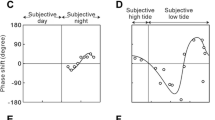Abstract.
Current models state that insect peripheral oscillators are directly responsive to light, while mammalian peripheral clock genes are coordinated by a master clock in the brain via intermediate factors, possibly hormonal. We show that the expression levels of two circadian clock genes, period (per) and Par Domain Protein 1 (Pdp1) in the peripheral tissue of an insect model species, the linden bug Pyrrhocoris apterus, are inversely affected by contrasting photoperiods. The effect of photoperiod on per and Pdp1 mRNA levels was found to be mediated by the corpus allatum, an endocrine gland producing juvenile hormone. Our results provide the first experimental evidence for the effect of an endocrine gland on circadian clock gene expression in insects.
Similar content being viewed by others
Author information
Authors and Affiliations
Corresponding author
Additional information
Received 31 October 2007; received after revision 7 January 2008; accepted 9 January 2008
D. Dolezel, L. Zdechovanova: These authors contributed equally to this work.
Rights and permissions
About this article
Cite this article
Dolezel, D., Zdechovanova, L., Sauman, I. et al. Endocrine-dependent expression of circadian clock genes in insects. Cell. Mol. Life Sci. 65, 964–969 (2008). https://doi.org/10.1007/s00018-008-7506-7
Published:
Issue Date:
DOI: https://doi.org/10.1007/s00018-008-7506-7



